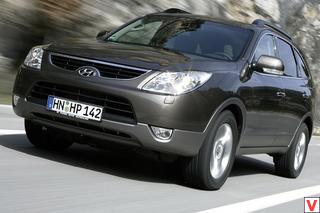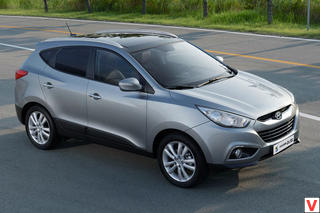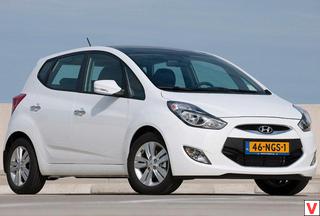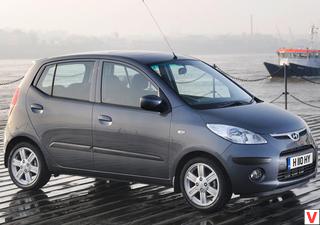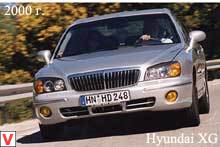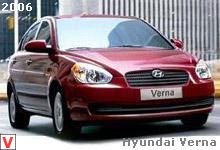
H1 debut in 1996. The car was positioned Hyundai as a loyal assistant, both for commercial and for family trips. Its prototype was Mitsubishi Space Gear, with which the H1 has a lot of similar features. Turning diameter of 11.2 - 12 meters, allows you to talk about the good maneuverability of the car. In the city, where the eternal problems with parking, help out sliding doors, which greatly facilitate the landing and loading. But the patency of the H1 is not as high as we would like. The combination of 190 mm ground clearance with a rather impressive wheelbase is clearly not off-road.
Available Hyundai H1 in various versions: with rear-wheel drive or four-wheel drive, with a short or long base. In early 2000, the car has undergone a slight modernization, updated exterior. In export markets, the car is known under the symbol H1 or H1 Starex, and in the French-speaking countries of Europe - as the Satellite. Transmission with rear or four-wheel drive equipped with a five-speed manual or four-speed automatic transmission. On the frame chassis, front double wishbone, torsion bar suspension, rear - a rigid bridge.
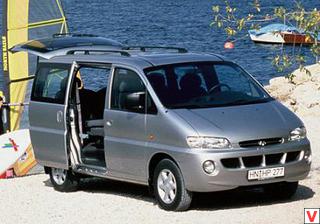
Anti-roll bar installed front and rear. Front brakes - ventilated disc, rear - drum. The Hyundai H1 has two features: firstly, it’s a rounded body that is not typical for a car of this class, and secondly, the rear door does not swing open with two pillars, but rises with one flap upwards. Lifting height 1.85 m, that is, most people can stand under it, without bending. Around the car there is a lot of controversy about which class this car belongs to.
Many attribute it to minivans, with which Koreans strongly disagree, who believe that a car capable of accommodating up to 12 people may well have the proud name of Maxiwen. The description of the salon should start with a landing, which is unusually high here, and if you add an impressive ground clearance here, you will get an image of a car that is hard not to notice in city traffic. A large glass area and mirrors help the driver to navigate the road.
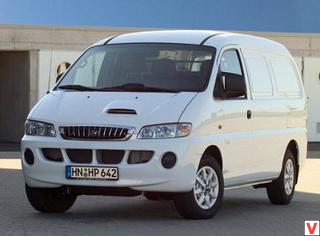
There are a huge number of body options - on two wheel bases, short and long, there are 7-, 9- and 12-seater passenger vans, as well as 3- and 6-seater cargo vans, and the latter can be either with glazed luggage compartment, or deaf The cars have three rows of seats, where all passengers can comfortably accommodate. It is worth noting the fact that the passengers of the rear seats will not feel a lack of space, since there is enough space for the legs and overhead, as well as special recesses for the legs in the lower part of the second row seats. It is noteworthy that the second row seats unfold and lock in any direction in increments of 90 degrees.
In addition, they can be moved back and forth. On the Hyundai H1, a ladder-type frame built into the body is used as a carrier element. The car has four-wheel drive, which is activated by pressing a button on the front panel.

The transmission is not equipped with a center differential, and when you turn on all-wheel drive, the engine torque is distributed in a 50/50 ratio. A self-locking differential can be installed in the rear axle, which equalizes the rotational speeds of both wheels when it slips. In 2004, the engine line was replenished 2.4 liters capacity of 135 liters. from. With the advent of the H1, Hyundai has strengthened its position in the growing segment of the van and minibus market. The car has incorporated the best features of the class MPV, as well as the reliability and versatility of the LCV (light commercial vehicle).
The second-generation Hyundai H-1 world debut took place in 2007 at the international auto show in Seoul. The updated H-1 offers consumers even more payload and passenger comfort. The car is made according to the classical scheme - the body is the carrier element, the engine is located longitudinally, torque is transmitted to the rear axle of the car. Compared with the previous H-1, the new model has become 90 mm longer and 100 mm wider, but the height has decreased by 40 mm. Despite the impressive dimensions (length 5125 mm, width - 1920 mm, height - 1930 mm, wheelbase - 3200 mm), the turning radius of the H-1 does not exceed 5.6 meters.
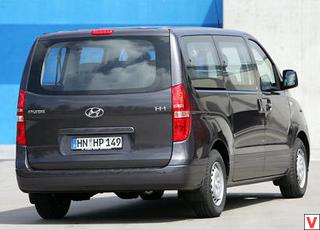
With a modern exterior design combines a practical and stylish interior. In terms of comfort for passengers, the Hyundai H-1 is not inferior to ordinary passenger cars. Ergonomics in the cabin thought out to the smallest detail.
The central panel of the minibus is elegantly placed with additional buttons for controlling the fog lamps and the rheostat. Attention to detail is also manifested in the fact that the switches for the window regulator and the settings for the rear-view mirror are gently recessed into the driver's side armrest. The passenger compartment has two rows of triple, split seats. In addition, the car offers a full set of pockets, cupholders and individual air deflectors for everyone in the cabin. It is noteworthy that you can enter the H-1 from both sides: there are sliding doors on the right and on the left.
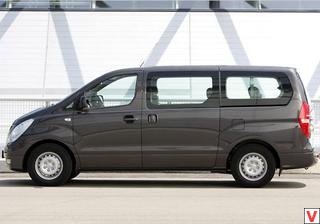
In addition, the front passenger H-1, if necessary, can freely move to the second row and back without leaving the car. If necessary, the car can be turned into a truck, adding up or completely removing the passenger seats. Moreover, the back of the sofa of the third row can be folded in parts and carry six people, along with lengthy meters on the right side. In short, the car is easily modified by the task of the consumer and can serve both for the carriage of goods, and for travel by a large company on a long journey. In Russia, the H-1 is sold with a 2.4-liter gasoline engine with 174 hp.
and a 2.5-liter diesel engine, existing in atmospheric and turbocharged versions (116 and 170 hp, respectively). An automatic gearbox is installed with a petrol unit and a manual transmission with a diesel engine. For exhaust fumes, the Hyundai H-1 engine complies with the European standard Euro-IV.
All wheel suspension independent. Independent front suspension - McPherson. Rear suspension - Rigid Axle 5-link. Safety of the driver and passengers in the Hyundai H-1 provide a solid body structure and a complete set of necessary airbags.
In the basic configuration of the Hyundai H-1 supplied to Russia, there are ABS, EBD, airbags for the driver and front passenger, disc brakes on all wheels, and the ESP has a dynamic stabilization system in the maximum configuration of the GLS. In Mexico, the car is sold under the name Dodge H100 Van / Wagon, while in China it is manufactured under license from Anhui Jianghuai Automobile and is called JAC Refine.
